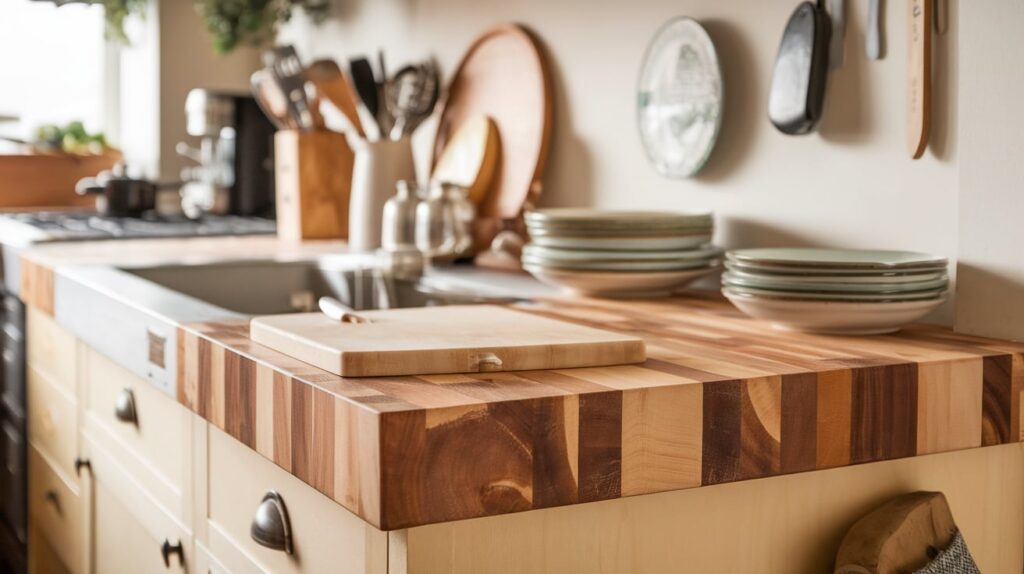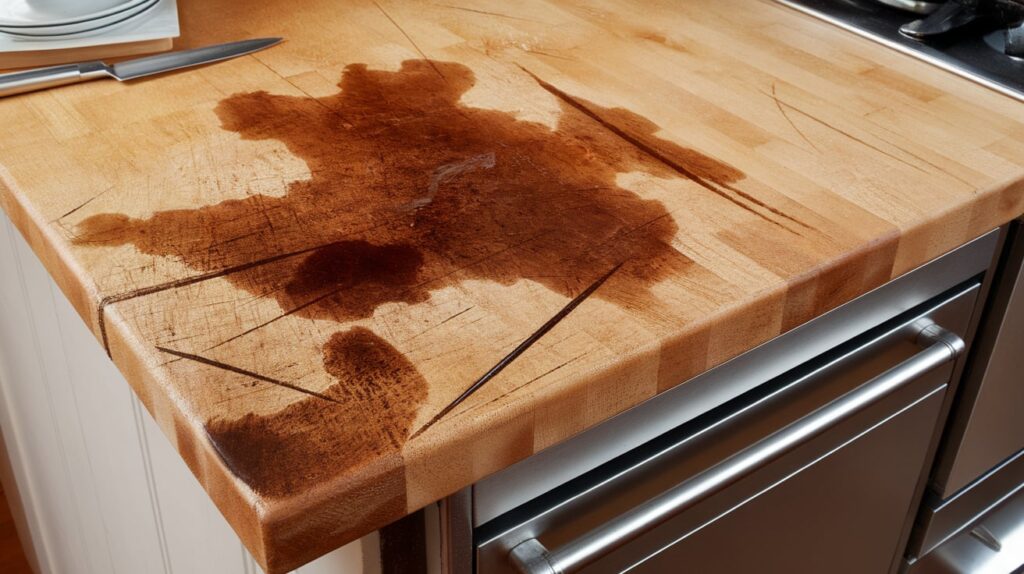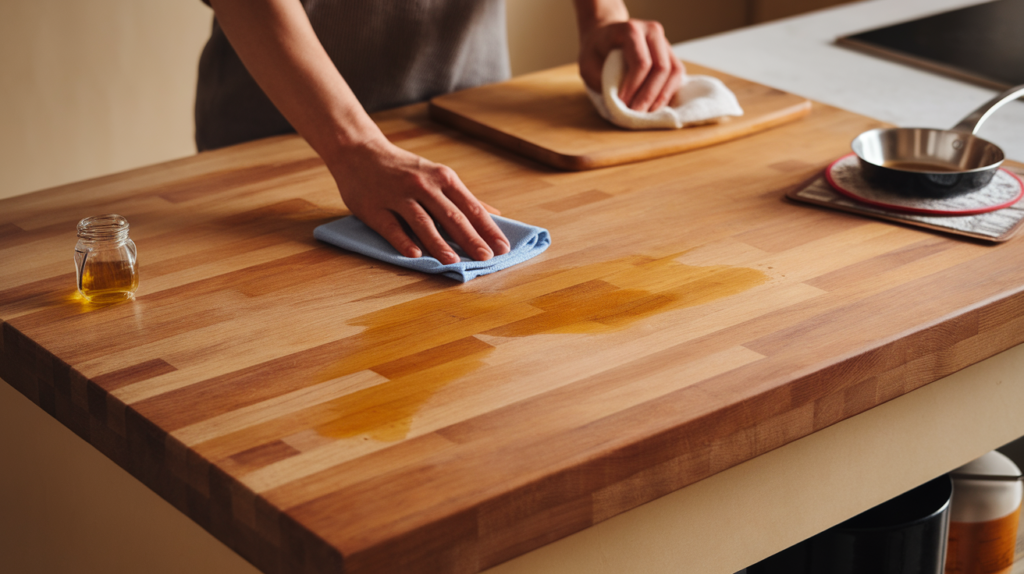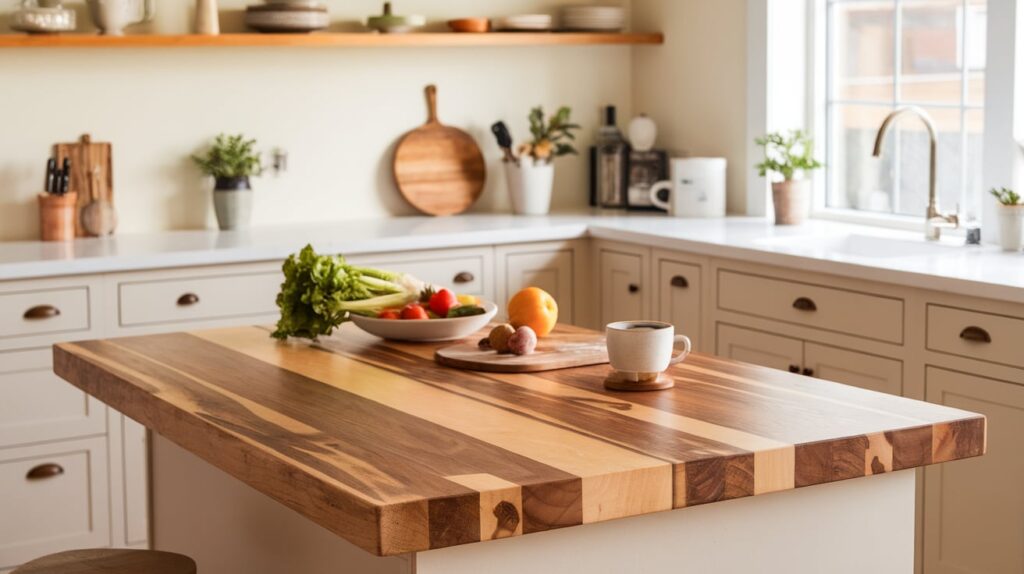Thinking about using butcher block countertops in your kitchen, but not sure if they’re the right choice? You’re not alone.
I’ve seen many people love the natural look of wood but worry about how it holds up over time. That’s what I’m here to help you figure out.
You’ll learn what makes butcher block great and what might make it a bit tricky to live with.
I’ll break down the good and the bad so you can see if it fits your kitchen and lifestyle. If you’re trying to balance beauty, cost, and care when choosing a countertop, this guide is for you.
I’ve kept everything simple and honest so you walk away confident in your decision. Let’s get into what you need to know before bringing a butcher block into your home.
What Are Butcher Block Countertops?
Butcher block countertops are made from straight cuts of wood glued together to form a thick, smooth surface. You might have seen them in cozy kitchens or homes with a natural, warm style.
They come in different wood types like maple, oak, or walnut, and each one has its own color and grain pattern.
These countertops are often used in kitchens because they give a soft, inviting feel. People also like that they can be sanded down if they get scratched.
Some use them for the whole kitchen, while others just use them on an island or a small section.
To keep them looking good, you need to care for them-things like oiling the surface regularly and wiping up spills quickly.
They’re a good fit for anyone who wants a bit of nature in their home and doesn’t mind doing a little upkeep to keep them in shape.
Advantages of Butcher Block Countertops

Butcher block countertops aren’t just nice to look at-they come with real benefits that make them a smart choice for many kitchens. These are some of the top reasons people love them.
1. Warm and Natural Look
Butcher block countertops bring in the warm, rich tones of real wood, creating a cozy and welcoming feel. The grain and texture add visual interest and depth that cold materials like granite or quartz often lack.
This natural style works well in farmhouse, rustic, or even modern spaces, making the kitchen feel more relaxed and lived-in.
2. Custom Styles
There’s a wide variety of wood species to choose from, like maple, walnut, oak, or cherry, each with unique colors and grain patterns.
You can also select different construction styles (edge grain, end grain, or face grain) and finishes, such as oiled or sealed surfaces. This flexibility allows you to match your countertops to nearly any kitchen design or color palette.
3. Gentle on Dishes and Tools
Because wood is softer than materials like granite or concrete, it’s kinder to your dishes and utensils. Accidental drops are less likely to lead to shattered plates or cracked mugs.
Additionally, the surface won’t dull your knives as quickly, which can help extend the life of your kitchen tools, though using a cutting board is still best.
4. Can Be Refinished
One of the most practical benefits of butcher block is that it can be sanded and refinished as needed. Over time, knife marks, water stains, or burns can make the surface look worn.
Instead of replacing the whole countertop, you can simply sand away imperfections and apply oil or sealant to refresh it. This makes it a long-lasting option if you’re willing to maintain it occasionally.
5. Safe for Food Prep
Properly sealed butcher block surfaces can be used for direct food preparation. While using a cutting board is recommended for longevity, you can cut fruits, veggies, or bread right on the surface in a pinch.
It’s naturally antimicrobial when cleaned properly, making it a safe and practical workspace for cooking.
6. More Budget-Friendly
Compared to natural stone or engineered quartz, butcher block is often more affordable. This makes it a great option for homeowners who want an updated kitchen look without spending a fortune.
And if you’re handy, butcher block is one of the few countertop materials that can be installed as a DIY project, reducing labor costs even more.
7. Eco-Friendly Options
Many butcher block countertops are made from sustainably sourced wood or even reclaimed materials. Choosing options with certifications like FSC (Forest Stewardship Council) ensures the wood was harvested responsibly.
Some manufacturers also offer countertops made from leftover wood scraps, helping reduce waste and promote green building practices.
Disadvantages of Butcher Block Countertops

While butcher block has many good points, it also comes with some downsides to keep in mind. Here are the main things to watch out for:
1. Needs Regular Care
Unlike stone or laminate, butcher block needs regular upkeep. You’ll have to oil it monthly at first, then every few months to keep it from drying or cracking.
Without this upkeep, the surface can become dull, brittle, and more vulnerable to damage.
Sealing is also important to protect against moisture and stains. If you prefer surfaces that can be left alone, a butcher block might feel like a chore.
2. Water Can Cause Damage
Wood is highly sensitive to moisture. Spills left sitting on the surface can seep into the wood and cause staining, swelling, or even splitting.
Areas around the sink are especially prone to damage unless sealed properly and wiped frequently.
Without fast cleanup and routine sealing, water exposure can lead to permanent issues that are hard to fix. This can be a challenge in busy kitchens where spills happen often.
3. Easily Scratched or Dented
Because wood is softer than most countertop materials, it’s much more likely to show scratches, knife marks, and dents.
Dropping heavy cookware or sliding appliances across the surface can leave visible damage. Even normal use over time may result in small dings or scuffs.
While sanding can fix minor flaws, that’s an extra step many homeowners may not want to deal with often.
4. Not Heat-Friendly
Placing a hot pot or pan directly on a butcher block surface can cause burn marks or discoloration. Wood doesn’t tolerate high heat like stone does, so you’ll need to be careful and use trivets or heat-resistant pads every time.
Even brief contact with heat can leave lasting damage, which limits how freely you can work on the countertop during cooking.
5. Must Be Kept Clean
Since butcher block is porous, it can absorb food residue and bacteria if not cleaned thoroughly.
This is especially risky when preparing raw meat or anything that could contaminate the surface. Regular cleaning with mild soap and immediate drying is necessary.
Disinfecting with vinegar or a food-safe cleaner can help, but if cleaning is skipped or done poorly, the surface can become unsanitary over time.
Comparing Butcher Block to Other Countertop Materials
Choosing the right countertop means looking at more than just appearance. This is a quick table that shows how butcher block compares to other popular options in cost, care, and style.
| Material | Cost | Durability | Maintenance | Style |
|---|---|---|---|---|
| Butcher Block | Medium | Moderate | Needs regular oiling and sealing | Warm, natural, cozy |
| Granite | High | Very durable | Needs occasional sealing | Classic, elegant |
| Quartz | High | Very durable | Low maintenance | Sleek, modern |
| Laminate | Low | Less durable | Easy to clean | Versatile, budget-friendly |
| Concrete | Medium-High | Strong but can crack | Needs sealing | Industrial, bold |
Each material has its strengths, so the best pick depends on your budget, style, and how much upkeep you’re willing to do. Butcher block is a great option for those who value natural looks and don’t mind a bit of extra care.
Who Should Choose a Butcher Block Countertop?

Butcher block countertops are a good fit for people who want a kitchen that feels warm and inviting. If you like the natural look of wood and don’t mind some light upkeep, this style might suit you well.
It’s also great for those who enjoy preparing food and need a surface that’s both useful and nice to look at.
Butcher block works best in kitchens that get regular, moderate use, where cooking happens often, but the counters aren’t exposed to heavy wear or a lot of water.
They’re perfect for dry areas, like islands or prep spaces away from the sink.
However, if your kitchen is always busy or you often deal with spills, hot pans, or heavy tools, you might need something tougher.
For many, the comfort and character of wood make butcher block a satisfying choice that blends beauty with everyday function.
Maintenance Tips for Butcher Block Countertops

To keep a butcher block looking good and lasting long, a little routine care goes a long way. These are some easy tips to follow:
- Clean gently: Use a soft cloth and mild soap to wipe down the surface after use. Avoid soaking it with water.
- Keep it dry: Wipe up spills quickly to prevent water damage or stains.
- Oil regularly: Apply food-safe mineral oil every few weeks to keep the wood from drying out.
- Use conditioner: A butcher block conditioner adds extra protection and keeps the surface looking fresh.
- Sand if needed: For scratches or stains, lightly sand the area with fine sandpaper, then reapply oil.
- Avoid heat: Always use hot pads or trivets under hot pans to prevent burn marks.
- Cut smart: Use a cutting board when chopping to keep the surface looking clean and smooth.
Conclusion
Butcher block countertops can be a great choice if you want something that feels warm, natural, and useful in your kitchen. I like how they bring a cozy look and are easy to work on when prepping food.
They do need more care than some other surfaces, but with regular cleaning and oiling, they can last a long time.
They’re not the best pick for kitchens that get really wet or need to handle heavy use every day. But for many people, the trade-off is worth it.
You get a surface that looks good and works well, as long as you’re okay with a little upkeep. If you’ve been trying to figure out if butcher block is right for you, I hope this helped you feel more sure about your choice.
Just think about how you use your kitchen, what you love, and how much care you’re willing to give.

